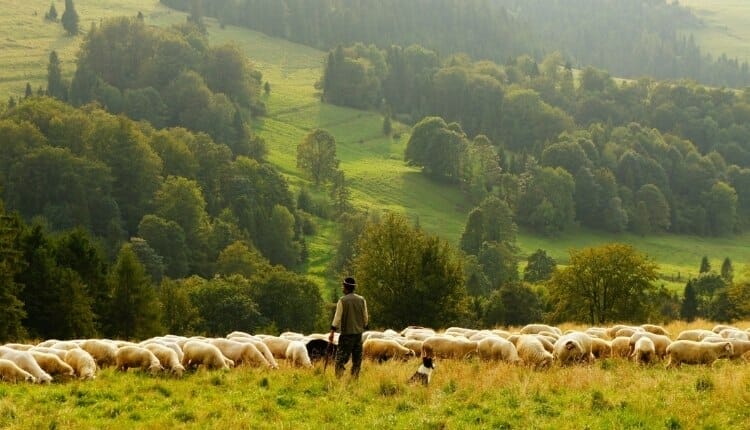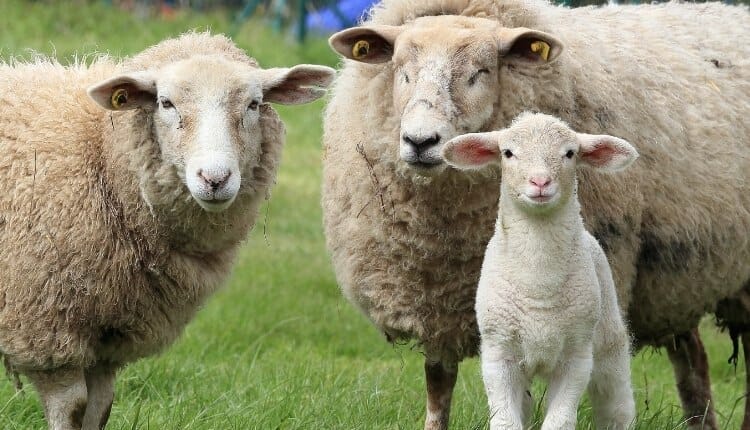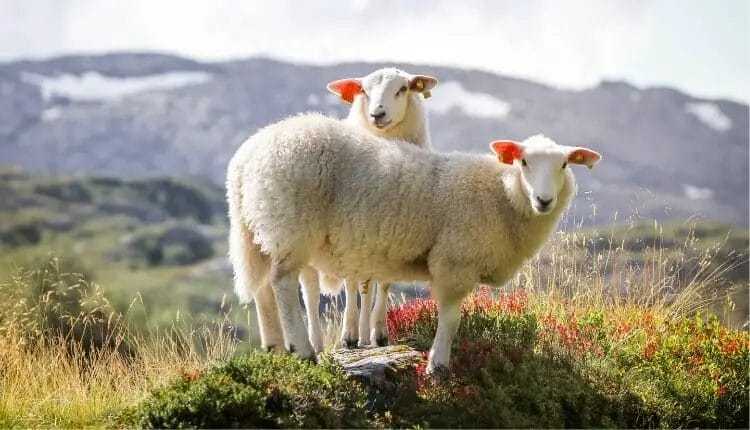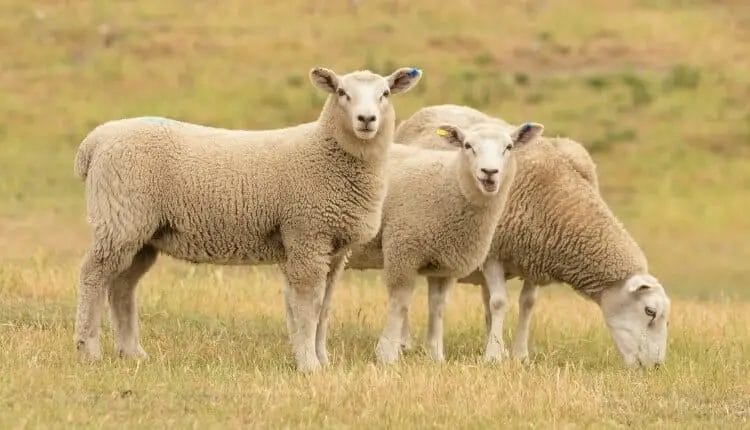The sheep farming business is profitable because they can be raised for their meat, wool, and milk. Besides, it is comparatively more straightforward than most other livestock.
Sheep farming is the process of raising and breeding sheep on a commercial farm to make a profit. That involves feeding, protecting, managing, etc. At the same time, it also includes accommodating information to local conditions, breeds, production methods, and markets.
At present, the demand for mutton and milk is increasing day by day. So, I have been commonly asked how to start raising sheep on farms and share some tips.
So, here in this article, I will share the exact seven steps that you can follow to start sheep farming from scratch.
Overview of Sheep Farming For Meat, Wool & Milk
Here is what you have to know before starting a sheep farming business.

In ancient times the sheep have been providing human food with protein and energy, where the demand is increasing day by day.
It’s an exciting process, but sheep farms operate on relatively simple principles. Remember that not all sheep farms are created equal.
Your business model will depend on multiple factors, including what you intend to do with your sheep.
With the help of wool collected from sheep, we are getting better quality clothes. And providing different leather products.
Thus the contribution of the sheep is impeccable in the history of human civilization. One of the main reasons the demand for mutton, wool, and milk increases regularly.
- The meat contains high protein levels,
- and milk contains calcium, which is very beneficial for the human body.
Is Sheep Farming Profitable?
Yes, it is. However, it’s not an easy endeavor; you must be aware of all that comes with raising sheep for a profit before making your final decision.
You may want to start expanding your business by buying extra land or setting up pens for sheep grazing. However, if you have never raised animals before, I suggest starting with one ewe at first if anything goes wrong.
In particular, sheep farmers need to understand what it takes—financially and otherwise—to run their operation successfully.
It’s easy to lose motivation during long working hours, but if you are passionate about what you are doing, anything is possible.
By learning more about what goes into starting a sheep farming business, you can make better-informed decisions about entering the industry.
Are Sheep a Good Investment?
As with any business, it’s essential to evaluate your investment upfront before you start. And as with most companies, there are ways to mitigate risk and increase profitability.
Contact your state department of agriculture. There, you’ll find a wealth of information regarding the sheep farming business.
And if you’re starting small or want to get your feet wet before diving in headfirst—consider starting by keeping pet sheep.
Is it a Good Idea for Beginners?
Yes, it is an excellent idea for beginners. Because even though there are some challenges and risks involved in the sheep farming business, you can earn handsome money by managing and taking care of these animals.
Besides, the initial investment for starting a sheep ranching business is relatively low compared to other farming activities.
Moreover, you don’t need vast land space because sheep are kept in small shelters, so there won’t be much problem finding suitable land for setting up your business.
Check the Local Regulations
You can’t keep lambs where you live, especially in urban areas. Contact the nearest district management, construction inspector, or local authority to see if only certain sheep breeds are better or mix breeding in which sheep are possibly granted. There are casts or other restrictions. You should also ask your landlord if you are renting land.
- Decide if you plan to keep sheep for your business or meet the family’s needs, as different rules may apply in each situation.
Sheep rearing can be a fun and rewarding job if well prepared. Find out more about the reasons for setting up a sheep farm and what to consider when starting this work.
Now, if you’re looking for information on how to start a sheep farming business, we’ll guide you through all steps in detail.
So,
How to Start Sheep Farming (in 7 Steps)

The first step towards starting any business is learning about it. It’s helpful for you to research your local climate, land availability, what permits are needed, how much it will cost, and what breeds are best for your area.
Generally, people start their farm in summer because winter care can be challenging.
After learning more about sheep farming, you should start planning your farm.
Doing research will help get you started on a small-scale project to test if it’s what you want to do.
Step 1: Select Appropriate Location for Your Farm
Thought you can choose abandoned, fully enclosed, or hybrid system. It raised sheep in the grazing-based and landless production system.
To run your business efficiently, you need to choose an area that is suitable for farming sheep. The climate should be moderate with high humidity levels.
You must check that there are no predators present in that area or if there are, you can take measures to prevent them from reaching your farm.
Check for any water scarcity issues as well as their impact on grass and vegetation. It would help if you also had sufficient fodder and grasses for sheep feed and natural pastures for grazing them.
Ensure that you have all requirements such as land, finance, and staff at hand before starting. If needed, the source for these requirements beforehand.
Get hold of books on sheep farming to keep yourself abreast of the latest updates regarding it.
Stage 2: Prepare the Barn or Housing

Raising sheep on your property requires a barn, coop, or other enclosed areas. Typically, these structures consist of three parts:
- an enclosed shelter (e.g., barn) where you house and feed your animals;
- Pen(s) where you keep animals; and
- an area for processing milk, wool, and meat.
Be sure to check with local zoning ordinances before building structures for raising livestock.
Many municipalities have regulations regarding allowable animals and the amounts of noise that such operations in residential areas might make.
You should also take steps to ensure predators don’t reach your animals; in most cases, electric fencing will do.
How much space do they need inside a barn?
Before starting a sheep farm, it is essential to calculate how much space will be required.
On average, each sheep will need 20- 25 square feet. And 1 acre of land for every 3-6 sheep. If you have more space, even better! You can fit many animals into a small area as long as they have access to food and water.
Step 2: Collecting The first Batch of Lambs

Sheep are social animals and rarely have a pure nature or try to escape if left alone. Therefore, you should keep at least two sheep in each fenced area.
Read on for advice on whether to buy a male or female lamb.
Determine how many male and female sheep to buy:
Ewes (female), ram(male), can differ in price. Besides, ram need separate places, may have a strong odor, and are often quite aggressive.
The easiest way to start a sheep farm is to buy a couple of ewes and ram.
- Custard lambs cannot reproduce or produce milk. They often sell these as farm pets. If too many sheep are born on their sheep farm, many people will be thrown away.
- If you want to buy a ram, you may consider paying extra for the breeding record. You will have more information about its features to help reduce your animal’s risk of genetic defects.
What should be age of the sheep:
Lambs that are about six weeks old are usually cheaper than older sheep. Furthermore, they are friendlier and easy to rise.
Lambs will mature in a short period, from six months to a year, and may even be parental (it will soon produce milk).
In the end, mature sheep and older sheep may be the least expensive option, but you should be careful with dairy farms. They want to sell the worst quality sheep among the animals.
Selecting sheep breeds:
Some sheep breeds suitable for dairy farming include Nigerian Dwarf, La Mancha, and Alpine. Other sheep breeds are for meat, such as Spanish or Tennessee.
Eventually, some farms buy angora or Kashmir sheep for cattle for sale. Find out which species of sheep usually grows in your area. Also, know about the size of each breed.
And the physical and personality traits of each breed after it grows up.
For example, some sheep breeds are more homogeneous, some have more intensely smelling male breeders, and some species are susceptible to certain diseases.
- Before deciding, you can learn how to milk, kill or scissor sheep hair.
- If you don’t want to kill the sheep yourself, you can find a professional slaughterhouse nearby to find an outlet before deciding to raise sheep meat.
Step 3: Build a Fence
The sheep are very good at shaking with narrow gaps or climbing on the wall. However, fences 1.5 meters or more high with strong “anti-climate” nets attached to the poles will be more difficult to climb or pass through than fences made with horizontal bars.
If you have both male and female sheep, you need to install a separate, incredibly long, fixed fence to keep the male sheep.
This fence will prevent the male sheep from reaching the sheep in the heat; It will help prevent them from mating unplanned.
- We should not keep the individual size of sheep together unless they are mother sheep, then a sheep is a kid.
- Male sheep can be very aggressive when kept with females, so you need to keep them separate even if you do not feel worried about the sheep’s unplanned pregnancy.
Step 4: Prepair A Shelter for Winter
Sheep need shelter when winter comes or it rains. A small pen is enough for a sheep. Densely coated sheep can tolerate cold weather but ask experienced sheep breeders first.
If you live in a temperate climate, the barn has three walls to help air circulation.
If you keep sheep in such a place during the cold winter months, you need to create a stable whole and keep them free from the wind, but you should take the sheep out during the day.
- Sheep hate and hate wet weather. If you live in an area with a lot of rainfall, you may need an indoor cage.
Stage 5: Understand The Basic Sheep Care
Sheep can live for as long as 15 years and require essential maintenance: food, water, shelter, and cleaning. Make sure your flock has fresh grass and hay daily and lots of clean water.
This farming is very promising because there is it require little care. However, whether you’re raising sheep for meat or wool may require extra care.
Sheep breed quickly and can keep in empty crop fields along roadsides and orchards during the day.
Farm management software can provide you with up-to-date information about your sheep farming business.
Proper care of sheep is essential to ensure their health. Ensure that your water supply is clean and that you have plenty of shade for them when they are in hot weather.
Here is what to do.
- Feet Trimming
- Shearing
- Deworming
- Vaccinating
Step 6: Learn Food Management Techniques for Sheeps
If they don’t have enough nutrients, they will not produce valuable wool or meat. Therefore, they should be given good quality hay and pasture during spring, summer, and fall.
You should have a minimum of 1.5 acres, ten ewes, and 2-3 acres for ten rams.
One of your most significant expenses will be feeding your sheep. However, when providing, you’ll need to consider what kind of food to buy.
It’s usually best to opt for complete feed, which includes both hay and grain. Although the entire feed is more expensive than hay alone.
It offers many benefits, including better weight gain, reduced risk of bloat, longer wool fiber growth, and better lamb survival rate.
When there is no grass in their grazing area during the winter months, make sure you give them good quality hay for at least five hours each day.
However, for optimal weight gain and efficient conversion of grasses into meat, your flock would need 4 acres or more.
You can expect your sheep to eat around 1% of their body weight in dry matter (hay/grass) each day as a rough guideline.
The more grass they can access, especially during hot weather, the less grain you will need to supplement with.
If you are wondering what to feed them read this article — what do sheep eat?.
Make sure you understand how much feed your animal requires and make sure to give them access to clean water at all times.
Water quality can be very important; many sheep will refuse water that doesn’t taste good, so if yours show signs of dehydration, invest in a high-quality water filtration system for them.
Step 7: Breeding
If you want to milk female sheep or give birth to baby sheep, you need to breed them when you reach the breeding age.
When the female sheep are hot, separate them from the flock and transfer them to the male sheep’s cage without doing the opposite.
Usually, 2-4 incisions are enough to ensure a pregnant female sheep. The average gestation period of a sheep is 150 days, but it can also vary by breed. However, you need to maintain the sheep breeding schedule.
Sheep Farming Business Plan

Estimate the cost:
Raising lamb varies from time to time and varies from region to region, as you make a profit by selling sheep products. If you plan to collect sheep for business, it is essential to expect the expected costs and profits.
Try talking to many sheep farmers or reading the latest sheep industry guidelines for a reasonably accurate cost estimate.
If the estimated results are higher than your budget, decide to buy fewer sheep or other breeds.
Keep in mind that sheep rearing may not be profitable for the first two years or more, especially if you plan to keep small sheep or have temporary expenses like fencing.
- How much does it cost to raise a female, male or baby sheep for one year? If possible, try to find an answer for the variety of your choice.
- If you raise sheep for milk, how much milk can a female sheep produce? How much milk can you sell?
- If you raise sheep for meat, you need to calculate how much a meat sheep will sell. Can sheep meat be more expensive at particular times of the year like Islamic, Christmas, or Easter?
- How much money do you need to be prepared to deal with unforeseen events like fence fixing or veterinary expenses? If a sheep dies, will it make you financially tricky.
Cast Management:
Even if you keep sheep for breeding, you need only one male for 25-50 females. Male sheep you are not planning to breed should be cast at about two weeks or older, but only when healthy. It would help if you asked your veterinarian to vaccinate sheep tetanus before the procedure.
- Male sheep have large testicles, so even a trimmed sheep does not appear to create.
Find out Where products Need to Sell:
Whether it’s selling meat products, feathers, milk, or a baby sheep, you need to find a market.
For small farms, the easiest way is to retail in the community or farmer’s market. Then, you can sell them online and ship them to order or sell to dealers if you have more products.
- Consider opening a farm for tourists and charging people when playing and playing with friendly sheep.
Frequently asked Questions About Starting a Sheep Farm
Are sheeps beginner-friendly?
Yes, sheep rearing is beginner-friendly. Because in the beginning most of the farmers have some problems. For example, they do not have enough capital to start a business. And this business can start with only two to four sheep with less money.
Also, in the beginning, the farmers did not have the proper experience. However, since sheep rearing is very easy and hassle-free, farmers can easily see the benefits of sheep farming at the beginning rather than other livestock farms. The chances of loss in their business are comparatively less.
How many sheep can a farmer keep mixed with cows and goats?
It usually depends on how the farmer raises his other animals. A farmer can usually keep 3-6 sheep mixed with cows and goats. Farmers keep 3-6 sheep mixed with cows and goats.
They kept sheep in separate rooms at night or with cows; during the day, they kept in open fields, along roadsides, in orchards, on leave, or tied. However, the number may be much higher.
The farm for rearing should have adequate space for every sheep, fair pasture land, and a good fodder supply. After ensuring all these conditions, it is possible to keep two sheep for each cow and one sheep for each goat.
What are the best sheep breed?
There are about a thousand varieties of sheep in the world, and they have divided the varieties into three parts: fur manufacturer, meat, and milk producer.
The names of the world’s famous lambs are Australian Bulula Marino, Awquisite, Baluch, Blue-Maine, Choice, Vala, Dorset, Hampshire, Linct, Marino, Nello, Nilgiri, Safak, Moon-Marino, Tunis and African Door, etc. And the Safok sheep are the biggest, whose weight is 125-180 kg.
For the production of meat (Suffolk Sheep, Dorper Sheep, Hampshire Sheep), for wool (East Friesian Sheep, Lacaune Shee, Awassi Sheep) is famous for the wool (East Friesian Sheep, Lacaune Shee, Awassi Sheep).
Why do people fail to profit?
Usually, sheep firming is safe and easy. But people sometimes make some significant mistakes because of their lack of knowledge.
As their newborn baby lambs die for improper care, sheep die in diseases, lost sheep, etc. So they can not make decent profits in their business. That’s why they fail in sheep firming.
How much profit can you make from ten sheep in a year?
It depends on which breed of sheep you are nourishing. But typically, in all sheep breeds, you can make almost two to three times more profit than your investment.
